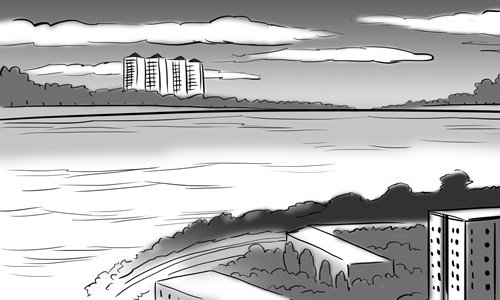China-Russia bridge will heal old wounds

Illustration: Liu Rui/GT
It takes only 20 minutes by ferry from Heihe in Northeast China's Heilongjiang Province to get to the Russian city of Blagoveshchensk across the Heilongjiang or Amur River. From the middle of the river, we can see an amusement park Ferris wheel on the Chinese side and high-rise apartments in Russia. The two banks are 730 meters apart.
A Russian journalist born along the Songhua River told us with a smile, "Many years ago, a Chinese would ask what was that beautiful place across the river when they first arrived in Heihe."
This immediately reminded me of the scene at customs where throngs of Russians returned home with as many commodities as they could carry. Nowadays will Russians who first arrive in Blagoveshchensk wonder how many goods they can buy across the river?
According to statistics from Knoema, a US-based company that provides access to databases, the region Amur Oblast, of which Blagoveshchensk is the administrative center, registered a per-capita GDP of 342,763 rubles in 2015 (about 38,897 yuan, $5,917), while Heilongjiang Province had 39,352 yuan per-capita GDP in the same year: roughly the same figure for both regions.
But Heilongjiang has a population of 38.12 million, while Amur has barely 800,000 residents.
And Heilongjiang's economic aggregate is much bigger than that of Amur Oblast.
From the comparison between the two regions, anyone can see that the best way to share economic growth between the two places is to build a bridge across the river.
This idea has constantly been raised in official and civil exchanges between the two regions over the last three decades. But it was not until last year that they started construction.
At a site near Blagoveshchensk, a Russian engineer told me that the bridge, with a total investment of 2.47 billion yuan, is scheduled to open in October 2019.
The tortuous, protracted project approval process for the bridge reflected not so much the economic demand on both sides but more a collective consciousness shaped over the long course of history.
A colleague who once visited Blagoveshchensk suggested I not take a photo at the city's Triumphal Arch. Chinese tour guides also remind Chinese tourists not to do so.
"Blagoveshchensk" means "city of the Annunciation" in Russian and the Triumphal Arch was built in honor of the visit of Crown Prince Nikolai Alexandrovich in 1891. Chinese people can never forget the Russians once claimed victory by occupying the vast territory across the Heilongjiang River.
In the appalling Blagoveshchensk incident nine years later, more than 5,000 Chinese people were killed. The Russians violently drove the Chinese out of the city, making the Heilongjiang River the demarcation line between the two nations.
More than a century has passed. China and Russia enjoy a clear border. But in the hearts of most Chinese people, the scar remains.
Russians are also quite sensitive to the arrival of Chinese people and their commodities.
Certain issues that have traditionally fallen within the domain of economics and trade are construed by some Russians as a front for Chinese labor force's encroachment.
Li Yongquan, a research fellow at the Chinese Academy of Social Sciences, once commented that while the Chinese think about how to develop faster, the Russians prioritize security.
Standing at the construction site and seeing the piers rise one by one, it is not hard to comprehend the precious achievements derived from 30 years of effort.
Now, finally, we can imagine the scene of the next 30 years when the two regions are closely connected.
The author is a senior editor with the People's Daily and currently a senior fellow with the Chongyang Institute for Financial Studies at Renmin University of China. dinggang@globaltimes.com.cn. Follow him on Twitter @dinggangchina

